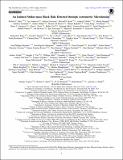An isolated stellar-mass black hole detected through astrometric microlensing
Abstract
We report the first unambiguous detection and mass measurement of an isolated stellar-mass black hole (BH). We used the Hubble Space Telescope (HST) to carry out precise astrometry of the source star of the long-duration (tE ≃ 270 days), high-magnification microlensing event MOA-2011-BLG-191/OGLE-2011-BLG-0462 (hereafter designated as MOA-11-191/OGLE-11-462), in the direction of the Galactic bulge. HST imaging, conducted at eight epochs over an interval of 6 yr, reveals a clear relativistic astrometric deflection of the background star’s apparent position. Ground-based photometry of MOA-11-191/OGLE-11-462 shows a parallactic signature of the effect of Earth’s motion on the microlensing light curve. Combining the HST astrometry with the ground-based light curve and the derived parallax, we obtain a lens mass of 7.1 ± 1.3 M⊙ and a distance of 1.58 ± 0.18 kpc. We show that the lens emits no detectable light, which, along with having a mass higher than is possible for a white dwarf or neutron star, confirms its BH nature. Our analysis also provides an absolute proper motion for the BH. The proper motion is offset from the mean motion of Galactic disk stars at similar distances by an amount corresponding to a transverse space velocity of ∼45 km s−1, suggesting that the BH received a “natal kick” from its supernova explosion. Previous mass determinations for stellar-mass BHs have come from radial velocity measurements of Galactic X-ray binaries and from gravitational radiation emitted by merging BHs in binary systems in external galaxies. Our mass measurement is the first for an isolated stellar-mass BH using any technique.
Citation
Sahu , K C , Anderson , J , Casertano , S , Bond , H E , Udalski , A , Dominik , M , Calamida , A , Bellini , A , Brown , T M , Rejkuba , M , Bajaj , V , Kains , N , Ferguson , H C , Fryer , C L , Yock , P , Mróz , P , Kozłowski , S , Pietrukowicz , P , Poleski , R , Skowron , J , Soszyński , I , Szymański , M K , Ulaczyk , K , Wyrzykowski , Ł , Barry , R K , Bennett , D P , Bond , I A , Hirao , Y , Silva , S I , Kondo , I , Koshimoto , N , Ranc , C , Rattenbury , N J , Sumi , T , Suzuki , D , Tristram , P J , Vandorou , A , Beaulieu , J-P , Marquette , J-B , Cole , A , Fouqué , P , Hill , K , Dieters , S , Coutures , C , Dominis-Prester , D , Bennett , C , Bachelet , E , Menzies , J , Albrow , M , Pollard , K , Gould , A , Yee , J C , Allen , W , Almeida , L A , Christie , G , Drummond , J , Gal-Yam , A , Gorbikov , E , Jablonski , F , Lee , C-U , Maoz , D , Manulis , I , McCormick , J , Natusch , T , Pogge , R W , Shvartzvald , Y , Jørgensen , U G , Alsubai , K A , Andersen , M I , Bozza , V , Novati , S C , Burgdorf , M , Hinse , T C , Hundertmark , M , Husser , T-O , Kerins , E , Longa-Peña , P , Mancini , L , Penny , M , Rahvar , S , Ricci , D , Sajadian , S , Skottfelt , J , Snodgrass , C , Southworth , J , Tregloan-Reed , J , Wambsganss , J , Wertz , O , Tsapras , Y , Street , R A , Bramich , D M , Horne , K & Steele , I A 2022 , ' An isolated stellar-mass black hole detected through astrometric microlensing ' , Astrophysical Journal , vol. 933 , no. 1 , 83 . https://doi.org/10.3847/1538-4357/ac739e
Publication
Astrophysical Journal
Status
Peer reviewed
ISSN
0004-637XType
Journal article
Description
Funding: L.W. acknowledges support from the Polish NCN grant Daina No. 2017/27/L/ST9/03221. J.-P.B. acknowledges support by the University of Tasmania through the UTAS Foundation and the endowed Warren Chair in Astronomy, and support by ANR COLD-WORLDS (ANR-18-CE31-0002) at Le Centre National de la Recherche Scientifique (CNRS) in Paris and the Laboratoire d’astrophysique de Bordeaux. U.G.J. acknowledges funding from the European Union H2020-MSCA-ITN-2019 under Grant no. 860470 (CHAMELEON) and from the Novo Nordisk Foundation Interdisciplinary Synergy Programme grant no. NNF19OC0057374. T.C.H. acknowledges financial support from the National Research Foundation (NRF; No. 2019R1I1A1A 01059609). Y.T. acknowledges the support of DFG priority program SPP 1992 “Exploring the Diversity of Extrasolar Planets” (TS 356/3-1).Collections
Items in the St Andrews Research Repository are protected by copyright, with all rights reserved, unless otherwise indicated.

